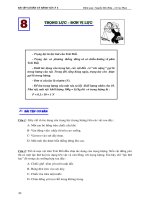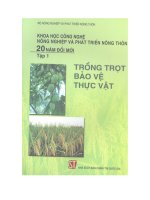Quá trình đồng nhất liệu trong silo và hoạt động của chúng
Bạn đang xem bản rút gọn của tài liệu. Xem và tải ngay bản đầy đủ của tài liệu tại đây (1.42 MB, 31 trang )
A Survey on Homogenizing and Blending
Silos and their Operation
EBOOKBKMT.COM
© Holcim Group Support Ltd
CMC APAC 2009
Raw Meal Beneficiation
Learning Objectives
Three major concepts in raw meal blending / homogenisation
Basic concepts for kiln dust handling
Kiln feed concepts
2
© Holcim Group Support Ltd
CMC APAC 2009
3 Silo Concepts for Raw Meal Beneficiation
Classification according to the kind of the working principle applied :
Multi-Pack gravity systems
Air-fluidized systems
Homogenising
silo
storage
silo
Air-fluidized systems Aerated gravity
following the
concept of the fully
agitated batch mixer
© Holcim Group Support Ltd
systems
following the concept
of a continuous
blender.
Multi-pack gravity
systems following the
concept of a continuous
blender.
3
CMC APAC 2009
Homogenizing Silo System
Batch type,
two store
arrangement
homogenizing silo
storage silo
EBOOKBKMT.COM
4
© Holcim Group Support Ltd
CMC APAC 2009
Homogenizing Silo System
Aeration System
Aeration
air supply
Lighter material rises in
homogenizing columns
Aeration
quadrant
Blending
air supply
Air cycling
valve
Blending
quadrant
Denser material
moves downward
Aeration
air supply
Homogenizing
air supply
5
© Holcim Group Support Ltd
CMC APAC 2009
Homogenizing Silo System
Operation
Performance Diagram of Batch Type Homogenizing Silo
200
S [ Ca O ]
100
2.5
2.0
1.5
Start
1.0
0.5
0.4
0.3
Target
0.1
[ min ]
180
160
140 120 100
80
60
40
20
0
Required homogenizing time
[ kWh/t]
0.3
0.2
0.1
0.0
Spec. energy consumption
6
© Holcim Group Support Ltd
CMC APAC 2009
concentration inlet
Homogenizing Silo System
Blending Efficiency
Silo inlet fluctuations
concentration outlet
time
Outlet fluctuations with a batch type homogenizing silo
goal mean
value
time of
one batch
© Holcim Group Support Ltd
quality step
between
batches
time
7
CMC APAC 2009
Homogenizing Silo System
Pros & Cons
Most efficient raw meal homogenizing system
Beneficiation potential 10:1
High energy consumer
Application limited to about 2000t vessels,
thus sufficient for production lines up to 3000t/d
High investment for new installations
8
© Holcim Group Support Ltd
CMC APAC 2009
Continuous Blending Silos Design concepts
1
8
Spider on top of silo for meal
distribution
Inverted cone concept
empty cone (IBAU; K-P)
5
4
2
7
3
center chamber (CPT)
Extraction by pneumatic control
valve
6
9
© Holcim Group Support Ltd
CMC APAC 2009
Continuous Blending Silos HGRS Silo Investigation
Material is flowing downwards to the silo outlet in
funnels of much smaller dimension than sector
dimensions
Mixing takes place at material surface by blending
material originating from different horizontal layers (i.e.
material that has been ground at different time)
Flow channels are located over the silo outlet
10
© Holcim Group Support Ltd
CMC APAC 2009
Continuous Blending Silo Design
IBAU type blending silo
No. of sectors:
>D
Cone/wall distance:
<2m
Max. air pad length:
< 2.5 m
Aeration air pad width 200 mm
Aerated bottom area: >35 %
2
6
EBOOKBKMT.COM
11
© Holcim Group Support Ltd
CMC APAC 2009
Continuous Blending Silos Operation
Operate the silos at high filling levels
(> 75 %)
Activate single sectors at a time rather
than two opposite sectors
Sector activation sequence preventing
intersection of funnels at material
surface
Min. aeration air rate > 1 m3/(m2*min)
Aeration sequence time 5 - 12 min
12
© Holcim Group Support Ltd
CMC APAC 2009
Continuous Blending Silo FLS-CF type blending silo
Max. air pad length: < 2.5 m
Aeration air pad width:
200 mm
1
8
5
4
2
7
3
6
Aerated bottom area:
35 – 50 %
Min. aeration air rate:
1 - 2 m3/min/m2
Aeration sequence time:
!!!
strictly follow the operation
manual !!!
© Holcim Group Support Ltd
13
CMC APAC 2009
Continuous Blending Silos FLS Operation Mode
No spider required on top of silo
for meal distribution
1
8
Flat bottom concept with
5
4
2
7
3
6
multiple (7) outlets
Product discharge at different
rates from the outlets creating
controlled declination of the
layers
14
© Holcim Group Support Ltd
CMC APAC 2009
c o n c e n tr a tio n in le t
Continuous Blending Silos
Blending Efficiency
Silo inlet fluctuations
c o n c e n tr a tio n o u tle t
time
Outlet fluctuations with
continuous type blending silo
goal mean
value
range of residual
fluctuations
time
© Holcim Group Support Ltd
15
CMC APAC 2009
Continuous blending silos can not blend long term
compositional fluctuations
Silo blending performance
5
1.6
short term fluctuations
long term fluctuations
5
20
16
© Holcim Group Support Ltd
CMC APAC 2009
Caused by:
Addition of kiln
lim e s a tu r a tio n
Continuous blending silos can hardly deal with peaks in
compositional fluctuation
SILO INLET
108
106
104
102
100
98
94
92
lim e s a tu r a tio n
feeder
110
96
dust into a
blending silo
Starvation of a
112
0
10
20
30
40
50
60
40
50
60
104
102
SILO OUTLET
100
98
96
94
92
0
10
20
30
time [ h ]
17
© Holcim Group Support Ltd
CMC APAC 2009
Continuous Blending Silos
Pros & Cons
Applicable for wide capacity ranges (5’000 – 20’000t)
Low energy consumer
Limited beneficiation potential 5:1
Decreasing beneficiation potential with increasing raw
meal uniformity ex raw mill
Insufficient reduction of
- long term fluctuations
- peak and step type disturbances
18
© Holcim Group Support Ltd
CMC APAC 2009
Multi-Pack Silo 7+1-Pack-Silo special application
Subsequent filling of silo cells
Simultaneous reclaim from all cells
Separate chamber for kiln dust handling
Suitable for very critical raw materials segragation, Q controle
Low - but fix blending efficiency depending on number of silo
Limited beneficiation potential 3:1
Higher Investment cost
© Holcim Group Support Ltd
19
CMC APAC 2009
Raw Meal Beneficiation
Learning Objectives
Three major concepts in raw meal blending / homogenisation
Basic concepts for kiln dust handling
Kiln feed concepts
20
© Holcim Group Support Ltd
CMC APAC 2009
Kiln Dust Handling
Problems
Separation factor
Tendency of a raw meal to cause segregation problems
Indication for high deviation of kiln dust chemistry from raw
meal chemistry
Sf LS
LS 32 m
or for existing plants
LS RawMeal
LSkiln dust
Sf
LSkiln feed
Critical
Not Critical
Critical
Sf < 0.8
0.8 < Sf < 1.2
Sf > 1.2
21
© Holcim Group Support Ltd
CMC APAC 2009
Kiln Dust Handling
Characteristics
Plant
LS
kiln feed
LS
recirc. kiln dust
0.8 < Sf < 1.2
AL
95.7
119.5
1.25
AP
93.4
110.4
1.18
AP
93.4
110.1
1.18
AT
93.2
88.6
0.95
EC
92.1
81.3
0.88
MI
93.9
97.4
1.04
OZ
93.1
93.9
1.01
PL
90.8
70.8
0.78
UV
90.2
81.3
0.90
22
© Holcim Group Support Ltd
CMC APAC 2009
Kiln Dust Handling
Option 1
Compound operation:
raw mix and kiln dust to blending silo
Direct operation:
kiln dust to blending silo
23
© Holcim Group Support Ltd
CMC APAC 2009
Kiln Dust Management
Compound operation:
Option 2
raw mix and kiln dust to blending silo
Sf not critical
compositional
Direct operation:
kiln dust to kiln feed bin
step variations
between
compound and
direct kiln
operation periods.
may become
excessive with
out-of-range meal
qualities (0.8 < SF
< 1.2)
24
© Holcim Group Support Ltd
CMC APAC 2009
Raw Meal Beneficiation
Learning Objectives
Knowledge of the three major concepts in raw meal
blending/homogenisation
Knowledge of the basic concepts for kiln dust handling
Knowledge of kiln feed concepts
25
© Holcim Group Support Ltd
CMC APAC 2009









